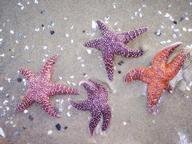FREE! Click here to
Join FunTrivia. Thousands of games, quizzes, and lots more!

Echinoderms (Starfish, Sea Urchins, Etc.) Trivia Questions and Answers
Fun Facts & Interesting Information
Fun Trivia Question Usage
You are welcome to use the questions in this section for non-commerical purposes: quizzing friends/coworkers, classrooms, newsletters, trivia nights, events, etc. Questions may
not be used for websites or in apps, and may not be resold. You use the questions at your own risk, and FunTrivia is not responsible for errors, etc in the content.
Please
link to or
credit FunTrivia textually (http://www.funtrivia.com) if you use any of these questions. Thanks!
Visit our
Trivia Question Store to buy question packs for commercial or for-profit ventures.
1. Are sea cucumbers animals or plants?

Answer: Animals
Interesting Information:A sea cucumber is certainly not a protist. Protists are single-celled organisms with a nucleus, such as algae, some forms of aquatic slime, and protozoic organisms. In reality, they are animals, and they live as animals with the several functions that qualify animals, including the lack of cell walls and the lack of special substances which allow the sustained life of the organism.
Difficulty: Average.
From Quiz: The Sea Cucumber
Some incorrect choices:
Plants, Neither, they are fungi, Neither, they are protists
2. What phylum is the sea star listed under?
Answer: Echinodermata
Interesting Information:Echinodermata is the correct answer to the question about the phylum of sea stars. This phylum includes not only sea stars, but also sea urchins, sand dollars, and sea cucumbers. Echinoderms are unique in that they have a water vascular system, which they use for movement, feeding, and respiration. They also have the ability to regenerate lost limbs, making them a fascinating group of animals to study. Some species of sea stars are even capable of reproducing asexually by splitting in half and regenerating into two separate individuals.
Difficulty: Hard.
From Quiz: Classification and Anatomy of Sea Stars
Some incorrect choices:
Arthropada, Porifera, Cordata
3. What does the word "echinoderm" mean?
Answer: spiny skin
Interesting Information:An interesting group including starfish, sand dollars, and sea cucumbers.
Difficulty: Average.
From Quiz: Starfish and Sand Dollars
Some incorrect choices:
smooth skin, grooved skin, no skin
4. Which phylum do sea cucumbers belong to?
Answer: Echinodermata
Interesting Information:Chordata are chordates, or organisms with spinal cords, or techically notochords. Hemichordata are acorn worms, marine invertebrates that technically have no notochord, but are stable and flexible. Nematoda are roundworms. Sea cucumbers instead follow the characteristics of echinoderms, including bilateral symmetry, tube feet, and external protective wall.
Difficulty: Hard.
From Quiz: The Sea Cucumber
Some incorrect choices:
Chordata, Hemichordata, Nematoda
5. The sea star has a _______ skeleton.
Answer: Flexible
Interesting Information:Sea stars, also known as starfish, have a unique skeletal system that sets them apart from other animals. Their skeleton is not made up of bones, but rather a network of small, interconnected plates called ossicles. These ossicles are made of calcium carbonate and are held together by a flexible tissue that allows sea stars to move and manipulate their arms. This flexibility also allows them to squeeze into tight spaces and pry open shells of their prey.
Difficulty: Hard.
From Quiz: Classification and Anatomy of Sea Stars
Some incorrect choices:
Exoskeleton, Green, Tough
6. What is the name for the dead 'shell' of a sand dollar when you find it washed up on the beach?
Answer: test
Interesting Information:A beach comber's treasure.
Difficulty: Hard.
From Quiz: Starfish and Sand Dollars
Some incorrect choices:
shell, bones, skeleton
7. What type of breathing system does the sea star have?
Answer: Water Vascular
Interesting Information:Sea stars, also known as starfish, have a unique breathing system called the water vascular system. This system not only helps them breathe, but also aids in movement and feeding. The water vascular system consists of a series of canals and tube feet that are filled with seawater. The sea star can control the amount of water in its system, allowing it to inflate or deflate its tube feet for movement and feeding. This system also allows for gas exchange, as oxygen is absorbed through the tube feet and carbon dioxide is released back into the water.
Difficulty: Hard.
From Quiz: Classification and Anatomy of Sea Stars
Some incorrect choices:
Gills, Lungs, Air vital
8. The sea star has the ability to ______ most body parts.
Answer: regenerate
Interesting Information:Sea stars, also known as starfish, have the remarkable ability to regenerate most of their body parts. This means that if a sea star loses an arm or even its entire body, it can grow back the missing parts. In fact, some species of sea stars can even regenerate a whole new sea star from just a single arm! This incredible ability is due to the sea star's unique water vascular system, which allows it to transport nutrients and oxygen throughout its body and regrow lost tissue.
Difficulty: Average.
From Quiz: Classification and Anatomy of Sea Stars
Some incorrect choices:
reproduce asexually, reproduce sexually, find
9. If a starfish loses one or more of its arms, what can happen to the center piece?
Answer: It can regenerate the arm(s)
Interesting Information:Starfish can regenerate missing parts. An injury such as this may leave the animal susceptible to infection so regeneration can't be guaranteed.
Difficulty: Average.
From Quiz: Starfish and Sand Dollars
Some incorrect choices:
Turn into an oyster, Turn into a barnacle, Come back together
10. What is the life span of a sea cucumber?
Answer: 5-10 years
Interesting Information:The life span will vary slightly from type to type of sea cucumber, as there are about 900 different kinds, but the general life span for the class of sea cucumbers is 5-10 years.
Difficulty: Hard.
From Quiz: The Sea Cucumber
Some incorrect choices:
1-2 years, 4-7 months, 30-40 years
11. The eye spot is located at the ______ of each ray.
Answer: Tip
Interesting Information:At the tip of each ray of a starfish is where you can find the eye spot. These eye spots are not like human eyes, but rather light-sensitive cells that can detect changes in light and dark. Starfish use these eye spots to navigate and find food, as well as to detect predators. Interestingly, some species of starfish have up to 50 eye spots on each ray!
Difficulty: Hard.
From Quiz: Classification and Anatomy of Sea Stars
Some incorrect choices:
Midpoint, Bottom, Inside
12. About how many species are in the phylum Echinodermata?
Answer: about 6000
From Quiz: Starfish and Sand Dollars
Some incorrect choices:
about 2000, about 3000, about 5000
13. What form of joint are the spines on an urchin attached to?
Answer: Ball and socket joint
Interesting Information:The spines are attached to ball and socket joints, thereby giving them the ability to move in almost any direction.
Difficulty: Hard.
From Quiz: The Mysterious (Yet Pointy) Sea Urchin
Some incorrect choices:
Hinge joint, Pivot joint, Saddle joint
14. What can the sea cucumber do if threatened?
Answer: Violently launch its insides at the threat
Interesting Information:This is seen as projectile vomit, but it is not actually vomit at all. I don't know how much receiving this unpleasant reception would hurt, but it would certainly be disgusting.
Difficulty: Hard.
From Quiz: The Sea Cucumber
Some incorrect choices:
Scurry away from the threat, Attempt to dig its way to safety, Explode, killing itself and the threat
15. Where can you find most of the animals in the phylum Echinodermata?
Answer: Sea
Interesting Information:Found only at sea and cannot be found in freshwater or land.
Difficulty: Hard.
From Quiz: Starfish and Sand Dollars
Some incorrect choices:
Fresh water, Land, All of the above
16. Where in the world is sea cucumber commonly considered a delicacy?
Answer: Eastern Asia
Interesting Information:More specifically, it is most commonly eaten in China, Japan, and Taiwan.
Difficulty: Average.
From Quiz: The Sea Cucumber
Some incorrect choices:
Northern Africa, Canada, The Middle East
17. Which class contains the brittle stars and the basket stars?
Answer: Ophiuroidea
From Quiz: Starfish and Sand Dollars
Some incorrect choices:
Asteroidea, Echinoidea, Holothuroidea
18. The surrounding areas in over-populated sea urchin environments are typically devoid of or severely lacking what?
Answer: All of These
Interesting Information:It is a biological condition called "urchin barren sea". It commonly occurs when the otter population, which is highly responsible for keeping urchin populations down, is lacking. The problem is fairly easily restored by adding otters or other common predators of the urchin to the area.
Difficulty: Hard.
From Quiz: The Mysterious (Yet Pointy) Sea Urchin
Some incorrect choices:
Kelp, Otters, Mollusks
19. Sea urchins cover themselves with small rocks, algae, and bits of shell to do what?
Answer: Hide from predators
Interesting Information:Urchins will pick up bits of things they find on the seafloor and carry them to hide from predators.
Difficulty: Average.
From Quiz: The Mysterious (Yet Pointy) Sea Urchin
Some incorrect choices:
Attract mates, Form shelter for the young sea urchins, Provide more surface area for the algae to form
20. Sea urchins have what form of symmetry?
Answer: Radial
Interesting Information:Bilateral symmetry is where one half is a mirror image of the other. Radial symmetry on the other hand is when the object is divided into one or more sections which resemble each other. Think of it as a pie being divided into separate, yet equal portions.
Difficulty: Hard.
From Quiz: The Mysterious (Yet Pointy) Sea Urchin
21. Most of the creatures in the phylum Echinodermata have a _____ part radial symmetry.
Answer: five
From Quiz: Starfish and Sand Dollars
Some incorrect choices:
six, ten, three
Please remember to credit FunTrivia.com, add links on your website or newsletters, or otherwise spread the word about our website. Thank you very much, and we hope these questions have been useful!
| 